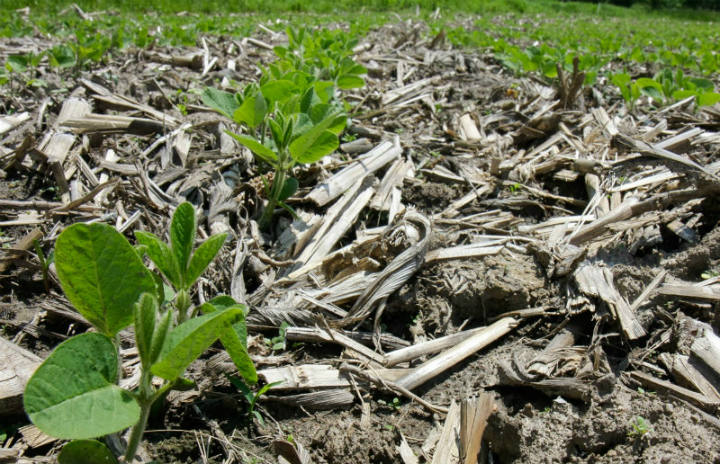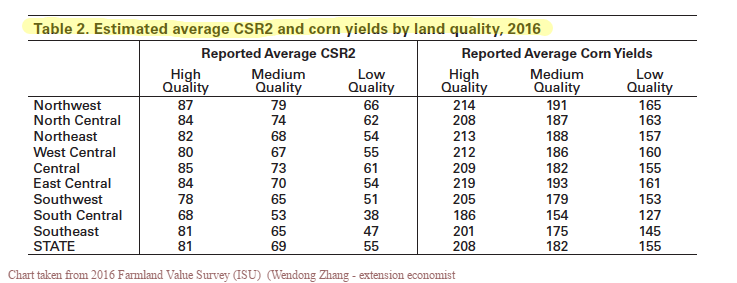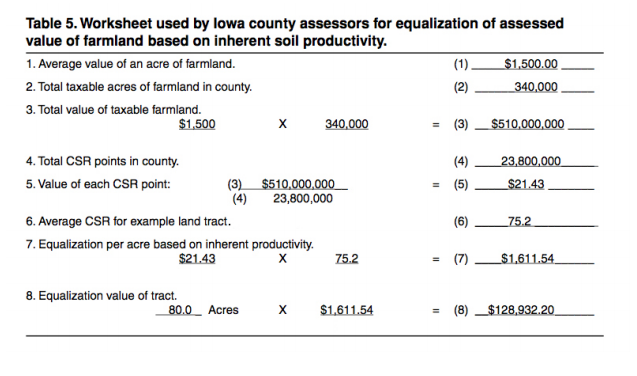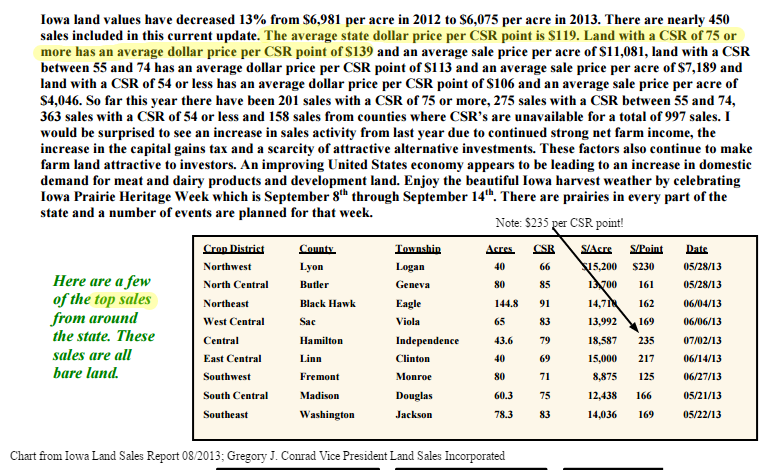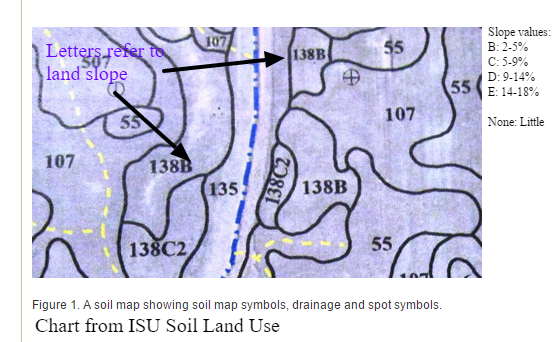His name was Brad.
It was one of those first-thing-out-of-bed and my hair-is-still-wet from the shower phone calls.
You know what I mean.
A still I’m very groggy and I-haven’t-had-a-cup-of-coffee yet phone call.
“I just came back from Iowa and I am really excited about finally being able to buy some land out there,” he quipped excitedly. He was calling from out of state – way, way, way – out of state. And had just come back from a successful Iowa deer hunt.
Sounds great, I said. I’m glad you had a great hunt. How much land are you looking for and in what part of the state?
“I’m looking for about 200 acres with a good mix of tillable and timber for hunting. I’m looking to spend up to $400,000 tops, and preferably, less.” he continued. “I need some good tillable to support my mortgage payment on the land; I need to get a really good rental rate of those acres to an area farmer.”
I really need to have something that brings in at least $20,000 per year in income,” Brad said. “I’m really excited about this and I’m ready to buy right away if I can find what I am looking for.”
“By the way,” Brad continued. What is this thing called CSR that a friend told me about the other day and what does it have to do with the value of land”?
We talked and talked for probably an hour-and-a-half and we covered a lot of bases in regard to his questions.
In the end, though, long story shorter, Brad did not end up buying any land at all – something in regard to a family situation popping up, I guess. But his call got me thinking of all the questions regarding Iowa’s CSR index — or corn suitability index — that I’ve had over the years.
The CSR index is unique to Iowa and I’ve found that many folks don’t really know what it is. So, I thought it was due time to shed some light on that.
Corn Suitability Rating examined:
The Corn Suitability Rating (CSR) was established in 1971 by Iowa State University as a means to rate the productivity of Iowa tillable soils.
With this system, soil are segregated in a meaningful way based on similar physical properties and are arranged into mapping units. Corn suitability rating (CSR) is based upon these different soil mapping units (smu’s), average weather conditions for the area, and upon the frequently of use of the soil for row crops.
Corn suitability rating’s range from 5-100. Five being soils that are severely limited in being able to be row cropped. And, with 100 being soils with few or with no physical limitations on being row cropped, having little or no slope, and that can be continuously row cropped.
As you can see, basically, the higher the CSR unit of the land the more valuable, from a production standpoint, it is to the farmer and to the landowner in general.
Something else to note about the CSR index is that it has gotten more accurate over time, as the overall knowledge base and classification of soils has become more refined.
The New Corn Suitability Rating:
In 2013, Iowa State University came out with a new version of CSR called the CSR2. You might deem this the new and improved CSR index.
Well, sort of.
The major difference between the old CSR and the new CSR2 has to do with rainfall. That being, the CSR2 value does not include a rainfall correction factor, built in, as did the old corn suitability rating.
It seems that, over time, rainfall rates have generally increased across Iowa so that having the correction factor was not needed.
Interestingly, that, in general, at least, CSR2 values tend to be higher in north-central and in northwest Iowa, than CSR values. For the rest of the state, the two indicators are very similar.
Keep in mind that with both indexes these assumptions exist: soil management units are adequately managed, are artificially drained when required and that there is no land leveling or terracing.
(Note: part of the above was taken adapted from Sassman, Buras and Miller – “A Comparison of Iowa’s Original CSR index to the new CSR 2 index. Dept. of Agronomy, Iowa State University).
Will the new CSR2 index affect my real estate taxes?
In general “NO”.
Here’s how the county assessor deals with CSR in relation to establishing real estate taxes.
As you may imagine, from our discussion so far, CSR values are directly tied to land values. In fact, The two are generally directly related. I say generally because this is not always so clearly defined as we’ll discuss in a second.
Iowa farmland prices in relation to CSR. (Sometimes CSR in relation to land prices is discussed as dollars-per-CSR point in relation to price per acre. For example a price of $100 per CSR point on X number of acres that have a CSR value of 60: Equals 60 points x $100 per point == $6,000 per acre)
Segmentation of Acres impacts production and valuation using just CSR Index:
When a farm is segmented, as so many recreational tracts are, the relationship between CSR value, as may be examined as CSR points-per-acre becomes less clear.
Example: A
A large crop field with easy access means it’s easy for the farmer to get in and out of to plant and to harvest. Lots of acres in one place also means the farmer does not have to relocate his equipment to a different location to do the same things. This saves him time and money.
Example: B
Suppose we have the same amount of acres as in example A. That is, the same amount of acres but they are broken up or segmented into several smaller fields. Separated, perhaps, by a creek crossing, parcels of timber, or a few miles distance between the fields. These things mean the farmer will need more time to plant and more time to harvest the same amount of acres as in example A.
It also means more expense because of the travel between fields with big equipment. Segmented fields also have more edge. This is great for wildlife, especially deer. But it does mean that these fields will receive more browsing pressure and predation from animals.
Smaller fields, in Iowa, tend to get heavily browsed by deer.
And, also, turkeys eat lots of planted seeds. Animals like raccoons, squirrels and, even beaver, eat seed and damage crops too. These things all play against the market and production value of smaller individual fields vs bigger fields with identical CSR values and the same amount of acres.
As can be seen in this comparison, two farms, each having identical acres and identical CSR indexes, can have very different real values to the farmer and, hence, to the landowner. In the market place, these acres would also have different market values.
So, using CSR values as a direct pricing mechanism when buying and selling can be a bit tricky and subjective.
Basing the value of acres using just the CSR index alone is not really enough.
One also needs to take into account these other factors such as field size, ease of access, animal browsing potential, edge component, and total recreational potential (This is not discussed here but we’ll hit this topic in a future blog post. Do note that the recreational market value potential goes up with field segmentation, in general. Just the opposite of valuation using of such fields using just the CSR index).
Looking at a Soils map: The Letters mean Slope
Something else you will see on soils maps are letters after the soils designated classification number. You see something like 13B. The number refers to how the soils is classified by mapping unit and the letter refers to the slope of the land.
B == 2-5% slopes
C== 5-9% slopes
D==9-14% slopes
E==14-18% slopes
(no letter designates little to no effective land slope)
As you might imagine, CSR and land the slope of the land have an opposing relationship. That is, the more the land slopes the lower is the CSR value.
And, therefore, usually, too, the lower is the value of the land, from a pure crop production valuation standpoint. (Not necessarily from a recreational value standpoint).
Stay tuned to our blog, as I’m sure we’ll discuss market valuation from a recreational value perspective – instead of just an income perspective — as it relates to CSR indexes of tillable acres.
Lastly, you might check out this video on soils and soil properties.

